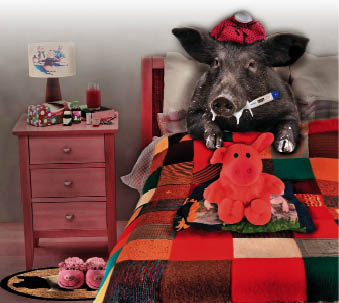You Lucky Pig - The Swine Flu doesn't Kill!
If you are planning on getting immunized against the Swine Flu in the near future, think twice—and read this article. Even the conservative British Times warns that the immunization is an “enormous and daring experiment”. Even Tamiflu is no life preserver, since 99 percent of the current flu virus strains are resistant to it. This is no reason to panic, however, since a pandemic just does not seem to be taking form, despite all attempts to convince us otherwise.

In spite of all the panic, the swine flu is quite harmless in humans and animals.
Since April, health experts have been talking about a flu pandemic that could strike down half the world. The media blow the same horn, regularly bombarding their readers and watchers with horror scenarios and—because in this current advice-culture we’re always simultaneously presented with a solution—call the insecure people, with official and medical blessing, to salvation: immunize!, immunize!, immunize!—and when it’s already too late—take Tamiflu!
The level of fear is regularly inflated and examples like the following are legion. From the middle of May 2009: “’Swine flu will rip through the globe in the next six months and affect one-third of the world’s population,’ says the World Health Organization’s Prof Neil Ferguson.
According to the expert, it will not be as catastrophic as the Spanish flu pandemic of 1918 that killed 50 million. But it is still possible that it could be like 1957—where 3 to 4million people died that year because of the pandemic worldwide.” (The Sun)
And from the end of August 2009: “More than 2 billion people worldwide could get it. Thousands of schools may shut down. And millions will need to be vaccinated—twice.” (Time magazine)
For the first time in decades, the WHO has proclaimed a global pandemic with the swine flu, which is, of course, increasing the sense of panic for the public.
Can sneezing kill?
And the young generation is so confused by this all (or is simply so conditioned to fear), that they don’t even know what the flu really is. The British actor Rupert Grint (alias Ron Weasly from the Harry Potter films) had this to say after his swine flu illness: “At first I thought, ‘am I going to die?’ But I just had a sore throat.”
Even the biggest worrywarts are of one mind when it comes to the fact that the swine flu is a harmless flu with very low mortality rates. Nevertheless, here and there people die from this flu. That is normal and not a great cause for excitement, however tragic each individual death may be.
Apart from the very valid question as to whether or not the numbers of flu victims quoted in the statistics actually died from the flu, even deaths numbering in the hundreds or thousands wouldn’t be that unusual—especially when you take them in relation to other numbers such as accident statistics, fatal wrong treatment or infections caught in hospitals, cancer rates, etc. In Mexico, where the current swine flu pandemic got its start, in April of this year 159 people had officially died from the illness. By July, the number had been quietly reduced to seven by the Mexican authorities.
Pigs that are properly kept do not usually get sick with the flu. They have to be purposefully infected with the H1N1 virus. And that is exactly what scientists did when they injected a litter of 22-day-old piglets not only with the swine flu virus but also with the much less contagious H3N2 virus. Only then did the animals develop the same flu symptoms as humans: nasal discharge, coughing, sneezing, and conjunctivitis. And, just like us, they were healthy again in less than a week. Not a single pig died.1
The Value of Pandemic Predictions
So why all this hysteria? The epidemiologist Tom Jefferson asked himself the same question and said in a Spiegel interview: “One of the extraordinary features of this influenza—and the whole influenza saga—is that there are some people who make predictions year after year, and they get worse and worse... Sometimes you get the feeling that there is a whole industry almost waiting for a pandemic to occur.” The Spiegel journalist asked: “Who do you mean? The World Health Organization (WHO)?”—“The WHO and public health officials, virologists and the pharmaceutical companies. They’ve built this machine around the impending pandemic. And there’s a lot of money involved, and influence, and careers, and entire institutions!”
The accused defend themselves with the justification that there is a risk that the relatively harmless but highly contagious swine flu virus could combine with a very dangerous virus, the bird flu virus, for example. A super-virus like that would certainly be a deadly threat for many, many people, they say, and that is why the spread of the swine flu must be stopped by all possible means. But contrary to the WHO’s panicked drum-beating, the virologist Daniel Perez gives the all-clear. This researcher at the University of Maryland has intensively researched the H1N1 swine flu along with other flu viruses and explains that the H1N1 virus does not interact with other viruses and, consequently, could not mutate to a super-virus. Perez also doesn’t believe that there will be a swine flu pandemic this winter.
But certain influential circles don’t like to hear that. They believe that the greatest threat to mankind’s survival is our ever-increasing numbers. That is why they want to drastically reduce the number of people on the planet—and what would be a more perfect way to achieve that than a highly contagious killer virus? Is the idea of getting a leg up on a Nature that is clearly too generous by tampering with viruses oneself to make them as deadly as possible really such a big leap?—But this kind of underhanded biological warfare is another topic, one that will be covered in the next issue of Facts are Facts.f
Secret plans like this could be a possible explanation for why we have been “prepped” with fear-fanning predictions about the possible arrival of these aggressive killer viruses for years. It really got going in the 80’s when mankind was supposedly threatened with extinction by the Aids virus. Thus Oprah Winfrey reported on her TV show in 1988: “one out of five heterosexuals could be dead of AIDS by 1990.” Instead, when faced with clear facts to the contrary, the WHO was obliged to declare an end to the heterosexual Aids pandemic in June 2008.
After HIV came other catchwords: Hanta virus, West Nile virus, SARS, bird flu, and now—swine flu. They all appeared suddenly and with great fanfare on the world stage to disappear again without so much as a peep. Between 2003 and 2009, fewer than 500 people were infected with the so-called bird flu; fewer than 300 actually died. In comparison: 250,000 to a half a million people die from the normal flu every year. Those numbers are from the official records of the WHO.
Are meat factories slinging out epidemics?
The public is supposed to believe that “evil viruses” would suddenly mutate out of nothingness and ravenously attack the innocent population, whose only protection are multi-billion pharmaceutical companies. But in reality, in some way or another, humans have also always muddied the water. The current swine flu hysteria is no exception: the first cases of swine flu appeared in the little Mexican town of La Gloria, which lies in the Mexican state of Veracruz. Why there? Probably because huge hog lots are found there, which are run by the biggest pork producer in the world, Smithfield Food, together in a joint venture with the Mexican company Granja Carroll de Mexico (GCM). Almost a million pigs are bred in these meat factories every year, confined in the most awful conditions and pumped full of antibiotics and medicine. 2,300 animals are killed daily in these factories alone. Their meat ends up in American fast-food chains such as McDonald’s and Subway, among others.
The US Company Smithfield Food takes advantage of NAFTA and produces their meat in Mexico, where the salaries are lower, the officials more corrupt, and the environmental laws are laxer than in the United States where, in 2000, the company was slapped with a $12,6 million bill for punitive damages because it contaminated the Pagan River near Smithfield, Virginia.
Already in March 2009, inhabitants of La Gloria were complaining about an “unusual” respiratory infection that, in some cases, led to a bronchial lung inflammation. At the same time, the unbearable stench from the open seas of sewage of the surrounding piggeries filled the air. Most of the sick people suffered from coughing, excessive mucous, and fever. 400 people sought medical help for these symptoms, but the health department estimates that roughly 1,800 of the entire 3,000 inhabitants of La Gloria suffered from this unusual illness—unusual because these kinds of flu symptoms do not usually appear in Mexico at that time of year.
It wasn’t until weeks later that the entire world was talking about a sudden and inexplicable outbreak of the ‘swine flu’. However, local residents, as well as local newspapers, environmental protection groups and doctors hold the hog lot companies accountable due to the contamination of the air and water through their business. A local health administrator pointed out that preliminary investigations indicated that a fly that bred in the pig excrement had transmitted the illness. In 2003, Science magazine warned that the swine flu virus was on an evolutionary “fast lane” due to the ever-growing hog lot industry and the correspondingly increased use of immunization in the animals. And in April 2009, the agricultural organization GRAIN publicized a report claiming that “the rise of large-scale factory farms in North America has created the perfect breeding grounds for the emergence and spread of new highly-virulent strains of influenza.”
But a study financed by the EU in 1998 had already come to the same conclusion: the more pigs are confined in unnatural ways in industrial settings, the worse their health and, therefore, the greater the risk of a swine flue outbreak.
Experts have estimated that the Smithfield Foods pigs produce at least 26 million tons of muck and dung per year. If the company had to meet the same requirements for managing this waste that big cities do, Smithfield Foods would lose money. So, instead, the waste flows unfiltered in great lakes of sewage around the Mexican city La Gloria.
This muck and dung is saturated with antibiotics and poisonous chemicals used by factory farms to “maximize efficiency”. Jeff Tietz, who has studied this problem intensely, finds the perfect words: “On a continuum of pollutants, it is probably closer to radioactive waste than to organic manure.”
But this wouldn’t be the first time that Smithfield Foods is responsible for an outbreak of swine flue. In 2007, it came out that the billion-dollar company had attempted to cover up a swine flu epidemic that had broken out in its hog lots in Romania. They left hundreds of dead pigs to rot in their stalls and refused access to local officials, even though the locals had complained to them about the stench.
Sources
- 1 Found in Virology Journal 2009; 6:34.






